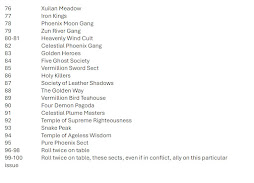This is part of my Wuxia Sandbox series. You can see the previous post HERE. These are all primarily written with Wandering Heroes of Ogre Gate and Righteous Blood, Ruthless Blades in mind but can be applied to most wuxia RPG campaign where sandbox is the focus. This series discusses a wide variety of methods and procedures I use. These should be regarded as tools, not as required steps in building a sandbox. I may use all, some or none for any given campaign. Every time I run a campaign, I take a slightly different approach based on what the needs of the current campaign are.
The purpose of this blog series isn't to set up proscriptive procedures. It is simply to give people a better idea how I run my wuxia sandbox campaigns.
My view on wuxia in RPGs is every GM has their own take on the genre, their own sensibilities about how to best bring it to the gaming table. This is true of any genre, but with wuxia it seems especially the case. Please do not take my advice as definitive in any way. Watch and read wuxia for yourself and form your own conclusions. What works for one GM, will completely miss the point for another.
FIASCO TABLES
Something I have been making use of in my campaigns recently are Fiasco Tables. These can also be thought of as event or hanging complication tables. They are an expansion on an idea I started adding to my grudge tables around the time of my Sons of Lady 87 Campaign. These can still be used with the Grudge Tables, but because those rely on a 2d10 bell curve, they don't quite get the effect I am going for in play as much as a dedicated 1d10 table in this particular campaign. In Ogre Gate I use a combination of 1d10 tables, 2d10 tables and d100 tables depending on what I am trying to achieve. Here the greater randomness is more the aim.
A fiasco table is simply a way to better manage things in a living adventure that can fall by the wayside. I talk more about Living Adventures HERE, but the basic idea is that NPCs and the world are reactive to the party, they are just as real as the PCs themselves and should be run like PCs. And for the most part, you don't need random tables for that. If the Gentle Demon of The Valley has taken an interest in the party, you can decide what he tries to do about it and how. He is a piece you control on the board. But sometimes the PCs do a bunch of things that warrant multiple parties becoming involved, and this is a simple way to track those things. When situations grow complex or shake up the martial world, I like shifting to Fiasco tables. It also boosts the excitement of a campaign by regularly rolling on the table to see when they come up.
 |
| Art by Jackie Musto |
These tables are somewhat specific. This one is for my campaign where the players have gotten their hands on the wind sabre of Sunan. This helps me to randomly determine who gets involved and how. Some results are parties already involved. Heiping Sect wants the sabre because it was stolen from them by the Witch of Zhaoze Zhou. Other results I will need to creatively interpret. The way I use tables is I look at the result and I try to reason through them and figure out a good explanation. Here I may have to puzzle through why sects who are opposed to one another are working together to get the wind sabre, or why the PCs enemies suddenly want to protect them. I did this intentionally to help produce more twists and turns to the game.
I view tables as creative prompts. And I think the art is in taking the results and arriving at something that is both interesting and makes sense. So I sometimes like results on tables that force me to square ideas. This table is essentially being used to help determine if anyone comes after the party to get the Wind Sabre for themselves. But there are a lot of possibilities that could arise depending on what combinations the dice yield.
I also realized I needed a general table on sects for this to work. Normally I rely on more local sect tables. But I put together a broad one that includes all the sects from the major books (note it doesn't include groups from some of the supplements yet, just Ogre Gate Inn, the Core Book, Sons of Lady 87 and War of Swarming Beggars). I may add more to this later.
If you look at the sect table, you will see it is a bit messy in appearance. This is also intentional. I wanted to show my thought process in putting the table together. I made a master list of the sects and then as I came to each one, I tried to decide if it was more likely or less likely to come up and decided the range of between 1-3 based on that. I may refine this further, as these were snap judgements.






No comments:
Post a Comment